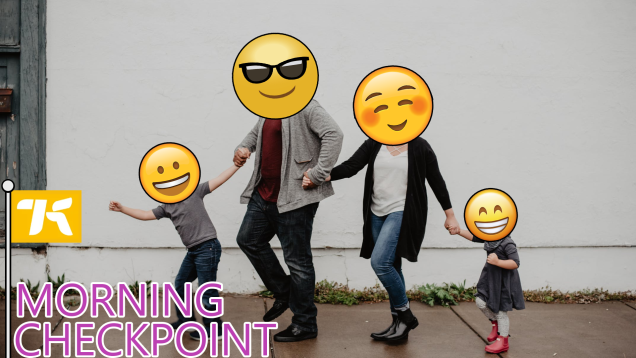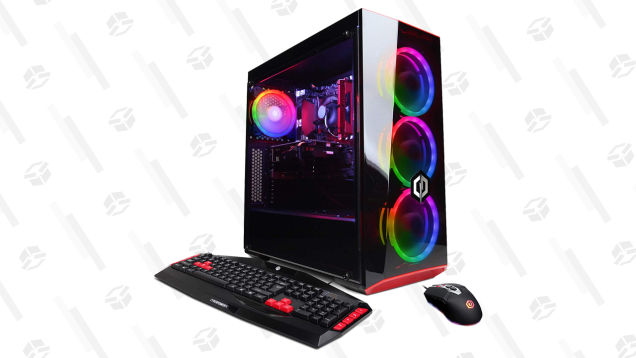
Hello! This week we explore The Oldest House, yell about Fortnite, watch a weird wrestling match, listen to Claptrap, call Lovecraft a stupid child and kill our emoji family.
Source: Kotaku – Please Don’t Kill My Emoji Family!


Hello! This week we explore The Oldest House, yell about Fortnite, watch a weird wrestling match, listen to Claptrap, call Lovecraft a stupid child and kill our emoji family.
Source: Kotaku – Please Don’t Kill My Emoji Family!
In addition to the new hardware support and other features queued already in DRM-Next for the upcoming Linux 5.4 merge window, on Friday AMD sent in a final pull request to DRM-Next of new material ahead of this upcoming kernel cycle…
Source: Phoronix – AMD Has A Number Of Graphics Driver Fixes To Add For Linux 5.4
For the first time since launching the Galaxy Note, Samsung has made two sizes of its flagship big-phone. The Note 10+ is a powerhouse, but frankly, I find the smaller Note 10 more intriguing. It has a slightly smaller screen than the Note 9, s…
Source: Engadget – Samsung Galaxy Note 10 review: The right size at the wrong price
Xiaomi has unveiled its new breed of Redmi Note smartphones boasting with high-performance SoCs as well as premium cameras. The new flagship Redmi Note 8 Pro is the industry’s first handset to feature Samsung GW1 64MP camera module, whereas the Redmi Note 8 offers a 48 MP camera at an entry-level price point.
The Xiaomi Redmi Note 8 Pro comes in a rather standard chassis comprised of an aluminum frame encompassed with Gorilla Glass 5 and features a 6.53-inch IPS LCD display with a 2340×1080 resolution as well as a 19.5:9 ratio. With a screen to body ratio of 91.4% (according to Xiaomi) and a rain drop selfie camera module, the device will be available in three colors: Mineral Grey, Pearl White and Forest Green.
Being a range-topping ‘Pro-level’ device, the Redmi Note 8 Pro is based on MediaTek’s flagship G90T SoC (two Cortex-A76, six Cortex-A55, quad-cluster Mali G76 at 800 MHz, AI-specific accelerators, dual-channel LPDDR4X controller, 12FFC) accompanied by 6 or 8 GB of LPDDR4X memory as well as 64 or 128 GB of NAND flash storage (expandable using a microSD card). The SoC is cooled down using Xiaomi’s LiquidCool cooling system (featuring a large piece of aluminum and a heat pipe) in a bid to sustain peak performance for prolonged periods. Performance wise, the new smartphone promises to be rather powerful, yet one of the main reasons to use the MediaTek G90T is because it supports a 64 MP camera module.
In fact, imaging capabilities are the key selling point of the Redmi Note 8 Pro. The main camera is comprised of the Samsung GW1 64 MP RGB module, an 8 MP ultrawide sensor with a 120° field of view, a 2 MP dedicated macro lens, a 2 MP depth sensor, and a dual-LED flash. Meanwhile, the phone also has a 20 MP camera for selfies.
Of course, the Redmi Note 8 Pro supports 4G/LTE: up to 600 Mbps downloads and up to 150 Mbps downloads. Other notable features of the Redmi Note 8 Pro include a 4,500 mAh battery, 802.11ac Wi-Fi, Bluetooth 5.0, NFC, IP52 splash-proof protection, a USB 2.0 Type-C port for data and charging, a 3.5-mm audio jack, an IR blaster, and stereo speakers.
The ‘younger’ brother of the family — the Redmi Note 8 — is naturally a more cost effective option. Coming in an aluminum with glass on the front and plastic on the back chassis, this smartphone has a 6.3-inch IPS LCD display with 2340×1080 resolution. It is based on Qualcomm’s Snapdragon 665 SoC (four Cortex-A73-like cores, four Cortex-A53-like cores, an Adreno 610 GPU, X12 LTE modem) that is paired with 4 or 6 GB of RAM as well as 64 GB or 128 GB of storage.
Even though it is positioned as a mainstream smartphone, the Redmi Note 8 also has a premium quad-module main camera comprising of a 48 MP RGB sensor, an 8 MP ultrawide sensor with a 120° field of view, a 2 MP dedicated macro lens, a 2 MP depth sensor, and a LED flash. It also has a 13 MP camera for selfies. Inherited from the ‘older’ brother are a USB Type-C connector, an IR blaster, and a 3.5-mm headset jack.
| The Xiaomi Redmi Note 8 Family | |||
| Redmi Note 8 Pro | Redmi Note 8 | ||
| Display | IPS LCD 6.53″ 2340×1080 Corning Gorilla Glass 5 |
IPS LCD 6.3″ 2340×1080 |
|
| SoC | MediaTek G90T 2x Cortex-A76 at 2 GHz 6x Cortex-A55 at 2.05 GHz quad-cluster Mali G76 at 800 MHz AI-specific accelerators dual-channel LPDDR4X controller 12FFC |
Qualcomm Snapdragon 665 4x Cortex-A73-like cores 4x Cortex-A53-like cores Adreno 610 GPU X12 LTE modem |
|
| RAM | 6 or 8 GB LPDDR4X | 4 or 6 GB DRAM | |
| Storage | 64 GB or 128 GB of NAND flash microSD card slot |
||
| Local Connectivity | Wi-Fi | 802.11ac Wi-Fi | |
| Bluetooth | Bluetooth 5.0 | ||
| Data/Charging | USB 2.0 Type-C | ||
| Audio | 3.5-mm jack stereo speakers active noice cancellation |
3.5-mm jack stereo speakers |
|
| NFC | Yes | – | |
| LTE | 4G/LTE CAT 12 UL 600 Mbps CAT 13 UL 150 Mbps |
X12 LTE | |
| Navigation | A-GPS, GLONASS, BDS | A-GPS, GLONASS, BDS, GALILEO | |
| Rear Camera | Main | 64 MP, f/1.8, 1/1.7-inch 0.8µm pixels PDAF |
48 MP, f/1.8, 1/2-inch 0.8µm pixels, PDAF |
| Ultrawide | 8 MP, f/2.2 13mm (ultrawide) 1/4-inch 1.12 µm pixels |
||
| Macro | 2 MP, f/2.4 1/5-inch 1.075 µm pixels |
||
| Depth | 2 MP, f/2.4 1/5-inch 1.075 µm pixels |
||
| Front Camera | 20 MP, f/2.0 | 13 MP, f/2.0 | |
| Battery | Capacity | 4500 mAh | 4000 mAh |
| Expected Life | ? | ? | |
| SIM Size | Nano SIM + Nano Sim | ||
| Sensors | accelerometer, gyro, proximity, compass | ||
| Biometric Security | Fingerprint | Yes (?) | Yes |
| Facial Recognition | – | – | |
| Dimensions | Height | 161.3 mm | 6.35 inches | 158.3 mm | 6.23 inches |
| Width | 76.4 mm | 3.01 inches | 75.3 mm | 2.96 inches | |
| Thickness | 8.8 mm | 0.35 inches | 8.4 mm | 0.33 inches | |
| Weight | 199 grams | 7.02 ounces | 190 grams | 6.7 ounces | |
| Colors | Mineral Grey Pearl White Forest Green |
Blue White/Grey Black |
|
| Protection | Drop | ? | – |
| Splashes | IP52 | – | |
| OS | Google Android 9.0 with MIUI 10 | ||
| Launch Countries | China initially, NA/EU launch later | ||
| Price | 6 GB + 64 GB — RMB 1,399 6 GB + 128 GB — RMB 1,599 8 GB + 128 GB — RMB 1,799
|
4 GB + 64 GB — RMB 999 6 GB + 64 GB — RMB 1,199 6 GB + 128 GB — RMB 1,399
|
|
So far, Xiami has introduced its Redmi Note 8 series only for China, where they will ship in September, but expect the smartphones to hit other markets in the future. The Redmi Note 8 Pro starts at RMB 1,399 for a 6 GB + 64 GB version and goes all the way to RMB 1,799 for an 8 GB + 128 GB model. The Redmi Note 8 is naturally cheaper: it costs RMB 999 – RMB 1,399 depending on configuration.
Related Reading:
Sources: Xiaomi/Redmi, GSMArena
Source: AnandTech – World’s First Smartphone with a 64 MP Camera: Xiaomi’s Redmi Note 8 Pro
Arbor’s fanless, rugged ”ELIT-1930” signage player runs Linux or Windows on an 8th Gen Coffee Lake-S CPU with up to 32GB DDR4, triple 4K displays, 2x GbE, 3x COM, 4x USB 3.1, and 3x M.2. Arbor Technology announced a new member of its ELIT series of digital signage systems equipped with Intel’s 8th Gen Coffee […]
Source: LXer – Coffee Lake signage player supports triple 4K displays

CyberpowerPC Gamer Xtreme VR Gaming PC | $649 | Amazon
Source: Kotaku – A Discounted Gaming PC, Plus a Free Game Download, Are in Play in the Gold Box

Mikhail Matz loves corals. As a biology professor at the University of Texas at Austin, Matz is well aware of the many threats corals face: global warming, pollution, ocean acidification, you name it. But when it comes to the danger posed by sunscreen chemicals—some of which are now banned in certain states and…
Source: Gizmodo – The Jury’s Still Out on How Bad Sunscreens Are for Corals
An anonymous reader quotes a report from Motherboard: Contract workers at Google’s office in Pittsburgh have just announced their intention to unionize. 66 percent of the eligible contractors at a company called HCL America Inc., signed cards seeking union representation, according to the United Steel Workers union. With the help of the Pittsburgh Association of Technical Professions (PATP), they’re asking the National Labor Relations Board (NLRB) for a vote on union representation. The PATP is a project sponsored by the union aimed at “helping Pittsburgh and Southwestern Pennsylvania workers in high-tech fields organize and bargain collectively.”
“Workers at HCL deserve far more than they have received in terms of compensation, transparency and consideration, and it has gone on like this for much too long,” HCL worker Renata Nelson said in a press release. “While on-site management tries to do what they can, where they can, their hands are often tied by arbitrary corporate policy.” The vote for union representation is an important step, necessary to empower a union to exclusively represent employees and negotiate on their behalf for a collective bargaining agreement. The move also represents an important step in the small but growing movement to unionize Silicon Valley’s workforce. The press release explains that HCL’s 90 employees “work side-by-side with those of the giant corporation for far less compensation and few, if any, of the perks.”
Read more of this story at Slashdot.
Source: Slashdot – Google Contractors In Pittsburgh Are Unionizing With a Steel Workers Union
Telegram will roll out an update designed to protect Hong Kong protesters’ identities in the coming days, according to Reuters. The upcoming feature will cloak users’ phone numbers to prevent authorities from being able to look up the people particip…
Source: Engadget – Reuters: New Telegram feature will protect HK protesters’ identities
In addition to NetBSD seeing better DRM ioctl support for its Linux compatibility layer (as part of an effort towards possible Steam support) thanks to Google Summer of Code 2019, there were also Wine improvements as a result of this Google programming initiative…
Source: Phoronix – Wine Is Now In Better Shape On NetBSD Thanks To GSoC 2019

The band YACHT, named for a mysterious sign seen in Portland around the turn of the century. [credit:
YACHT / Google I/O 2019 ]
The dance punk band YACHT has always felt like a somewhat techy act since debuting in the early 2000s. They famously recorded instrumental versions of two earlier albums and made them available for artists under a Creative Commons license at the Free Music Archive. Post-Snowden, they wrote a song called “Party at the NSA” and donated proceeds to the EFF. One album cover of theirs could only be accessed via fax initially (sent through a Web app YACHT developed to ID the nearest fax to groups of fans; OfficeMax must’ve loved it). Singer Claire L. Evans literally wrote the book (Broad Band) on female pioneers of the Internet.
So when Evans showed up at Google I/O this summer, we knew she wasn’t merely making a marketing appearance ala Drake or The Foo Fighters. In a talk titled “Music and Machine Learning,” Evans instead walked a room full of developers through a pretty cool open secret that awaited music fans until this weekend: YACHT had been spending the last three years writing a new album called Chain Tripping (out yesterday, August 30). And the process took a minute because the band wanted to do it with what Evans called “a machine-learning generated composition process.”
“I know this isn’t the technical way to explain it, but this allowed us to find melodies hidden in between songs from our back catalog,” she said during her I/O talk. “Here’s what the user-facing side of the model looked like when we recorded the album last May—it’s a Colab Notebook, not the kind of thing musicians usually bring into the studio.”
Read 21 remaining paragraphs | Comments
Source: Ars Technica – How YACHT fed their old music to the machine and got a killer new album

Zero Grid Card Holder | $8 | Amazon | Clip the $1 coupon and use promo code ZHJM3QHT
Source: Gizmodo – Combine Your Phone and Wallet With This Card Holder
The Intel Icelake Linux support has largely been squared away for months but one lingering important feature for many is the Thunderbolt support and that’s now set to be introduced with the upcoming Linux 5.4 version…
Source: Phoronix – Intel Icelake Thunderbolt Support Queued Ahead Of Linux 5.4
There are many technical problems to be solved before this popular, formerly proprietary file system can be in the shipping open-source Linux code.
Source: LXer – ExFAT is on its way to the Linux kernel

Enlarge (credit: Anca Gabriela Rafan / EyeEm / Getty)
Almost two dozen women say they were tricked into appearing in pornographic videos on the prominent porn site GirlsDoPorn. They sued the owner of the site, Michael Pratt, for fraud in 2016. The trial began in mid-August and is expected to run for more than a month.
One of the victims wrapped up her testimony in a San Diego courtroom on Monday.
“If I had known that they were posting it on the Internet, that my name would be attached to it, that it would be in the United States,” the woman identified as Jane Doe 15 said in court, according to the Daily Beast. “If I had known that it was more than 30 minutes of filming, if I had known any of that, just any one of those, I wouldn’t have done it.”
Read 16 remaining paragraphs | Comments
Source: Ars Technica – GirlsDoPorn.com faces trial for allegedly filming 22 women under false pretenses
The EOMA68 computer card design was novel when first talked about for integerchangeable Arm-based computer cards that could also be installed within laptops and other devices. But even after being worked on for years and raising more than $234k USD, it’s still not ready yet to see the light of day…
Source: Phoronix – The EOMA68 Upgradeable ARM Board Faces Another Setback: HDMI Connectors Don’t Fit
Severed heads. Skulls on stakes. Surfers in a gun battle. A bridge rebuilt and blown up every night. Painted faces. A jungle swallowed in flame. Wagner. The Doors. Sweat. Malaria. And so many helicopters, their blades pounding relentlessly. Only Crazy Grenade-Launcher man knows “who’s in charge here,” and he ain’t saying.
Yes, Apocalypse Now is back. For its 40th anniversary, the movie has been remastered in 4K digital and re-edited before heading to Blu-ray and 4K/Ultra HD discs. The nightmarish Vietnam War epic is the quintessential example of the “cinema of endurance”: long, grueling, magnificent, and LOUD. When Apocalypse Now first hit theaters in 1979, it ran about 2.5 hours, but its 2001 re-release (dubbed Apocalypse Now Redux and presented in 35mm) clocked in at a whopping 3 hours and 22 minutes. The newest version, Apocalypse Now Final Cut, comes in at about 3 hours.

Martin Sheen stars as Captain Willard. Sheen is best known for being Paula Abdul’s father-in-law from 1992 to 1994. [credit:
Lionsgate
]
Before heading to home video, Final Cut gets a brief theatrical run so you can watch it the way God and Director Francis Ford Coppola intended: on a huge screen in a dark room with no ability to hit pause and escape. Many theaters are also showing it on Sony’s cutting-edge 4K Laser Cinema Projectors, which only hit the market about a year ago. Although most cinema projectors are already 4K, the 4K Laser replaces the xenon bulbs used by most projectors with a longer-lasting, brighter, and more-consistent laser.
Read 20 remaining paragraphs | Comments
Source: Ars Technica – Watching Apocalypse Now Final Cut in Sony 4K Laser
This past week was GNOME’s annual developer conference, GUADEC. Video recordings from all the presentations at this event in Thessaloniki, Greece are now online…
Source: Phoronix – GNOME’s GUADEC 2019 Videos Available Online
After analyzing high-growth companies in the United States, a team of economists discovered that most superstar entrepreneurs are middle-aged. Their study is being published in the journal American Economic Review: Insights. The New York Times reports: The researchers looked at start-ups established between 2007 and 2014 and analyzed the top 0.1 percent — defined as those with the fastest growth in employment and sales. The average age of those companies’ founders was 45. There are, of course, famous counterexamples. Mark Zuckerberg was 19 when he co-founded Facebook. Bill Gates was 19 when he founded Microsoft with Paul Allen. Steve Jobs was 21 when he founded Apple with Steve Wozniak. The origin stories of those companies and a handful of others helped to shape a myth that tech, and American innovation overall, is fueled by wunderkinds. But fresh-faced founders are the exception, not the rule, according to the study.
The new study was able to zero in on high-flying start-ups by bringing together anonymized data collected by different agencies within the federal government. The government matched sales and employment data for start-ups collected by the Census Bureau with information on the founders extracted from Internal Revenue Service filings. After stripping identifying information, the government provided the researchers with a data set including 2.7 million business founders. The researchers calculated that the founders’ average age was 42. And for the founders of the 0.1 percent fastest-growing firms, the average age was 45. Firms that were successful enough to have an initial public offering or be acquired by a larger company showed the same pattern: Their founders were generally middle-aged.
Read more of this story at Slashdot.
Source: Slashdot – Founders of Successful Tech Companies Are Mostly Middle-Aged
Collabora put out a fresh technical blog post today to talk a little about virglrenderer, with the latest version enabling a big leap for accelerated OpenGL within a virtual machine.
Source: LXer – Accelerated OpenGL in a virtual machine is advancing with virglrenderer